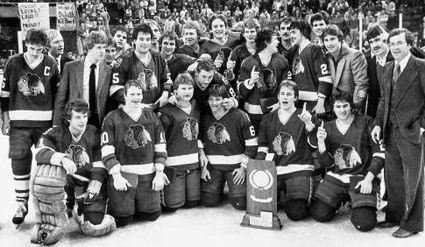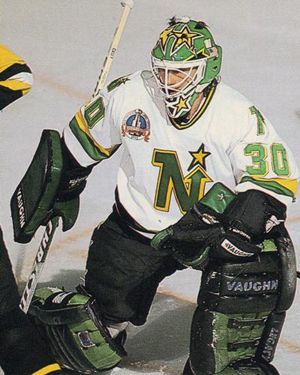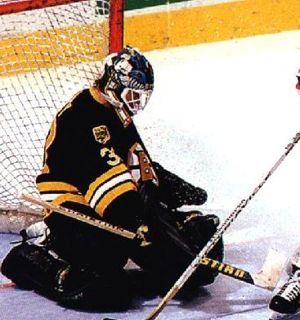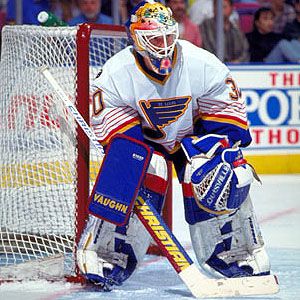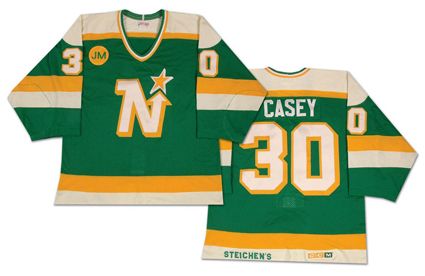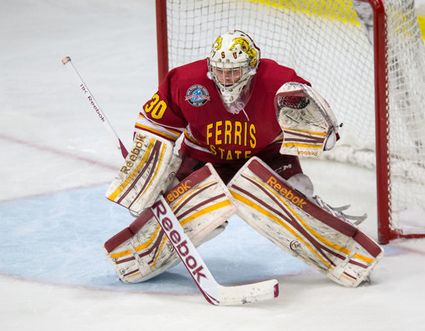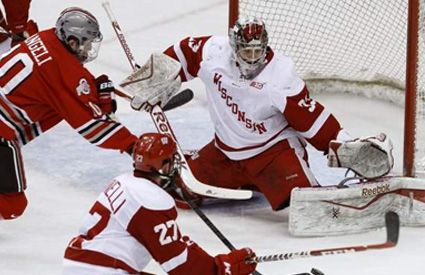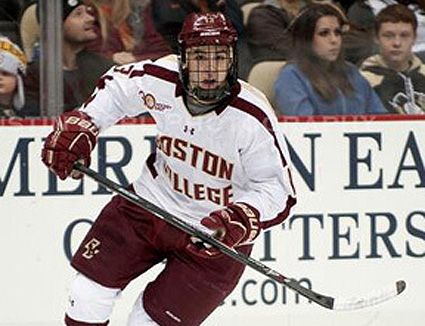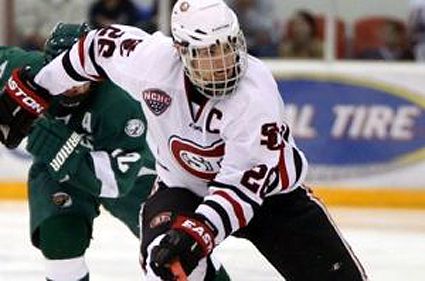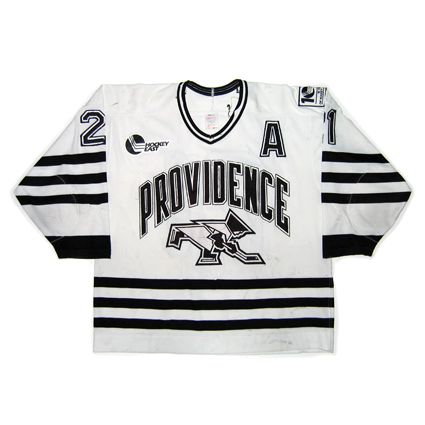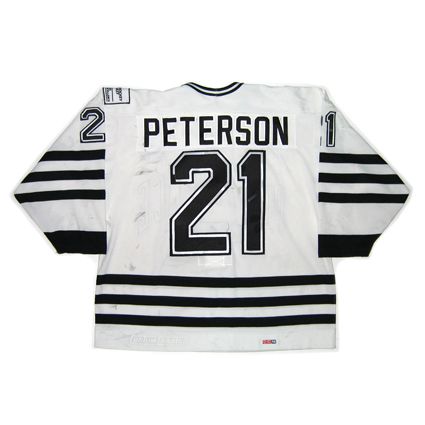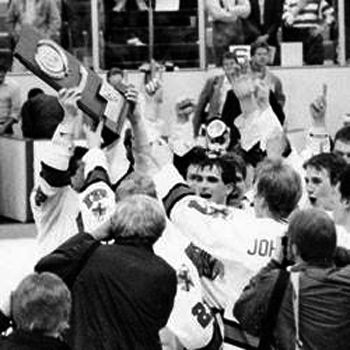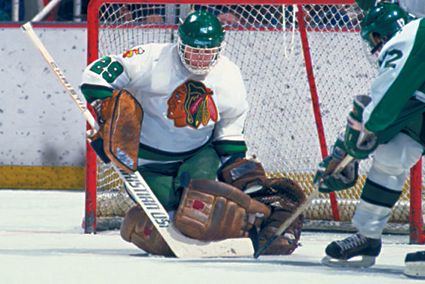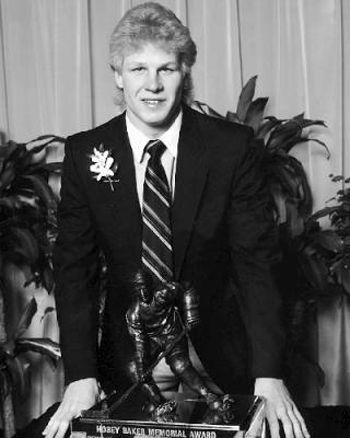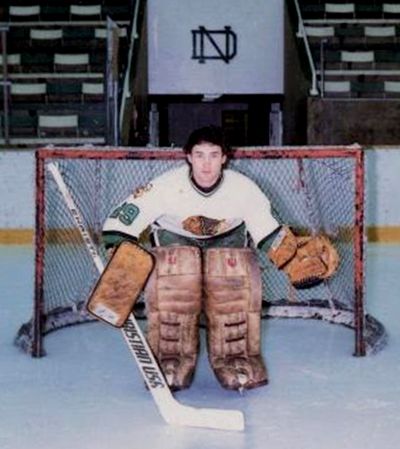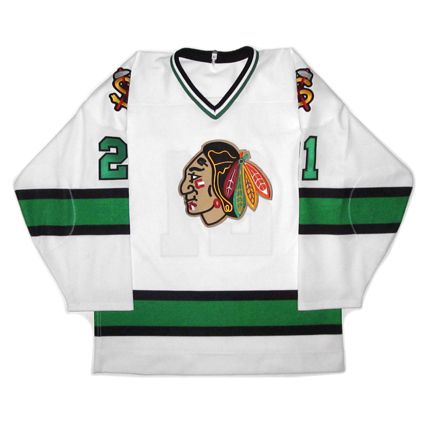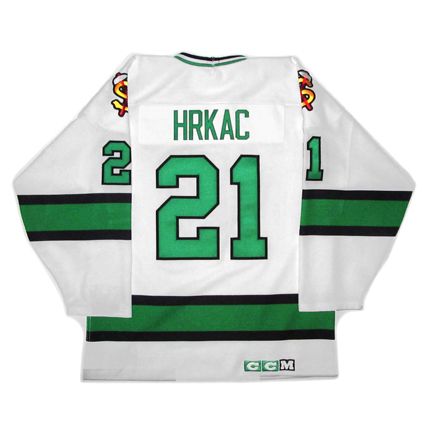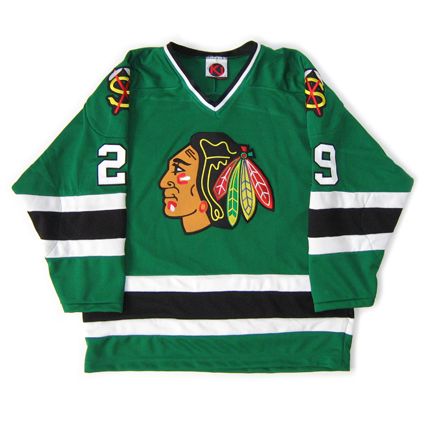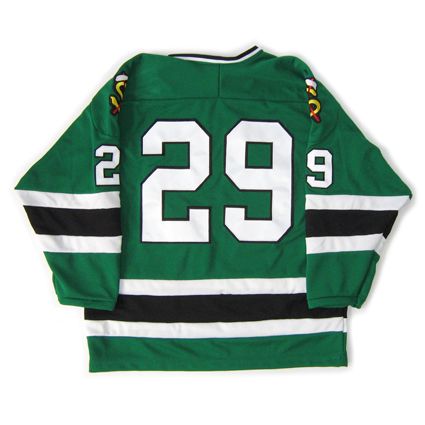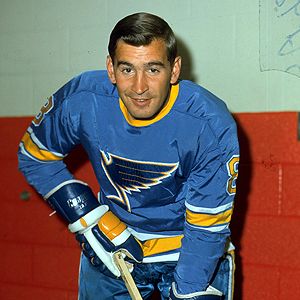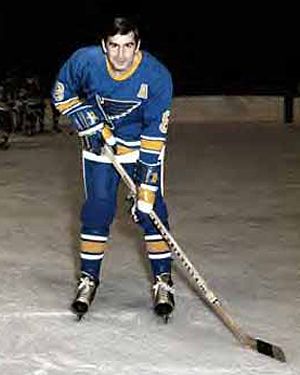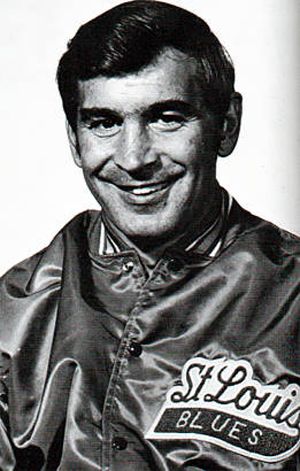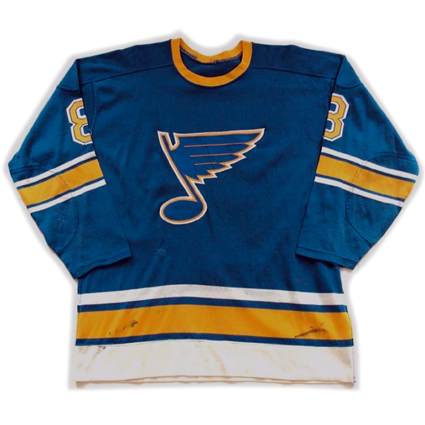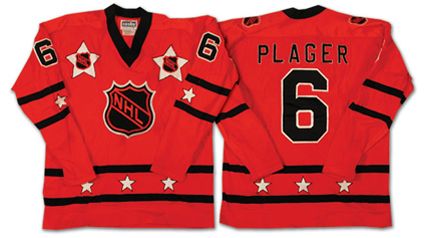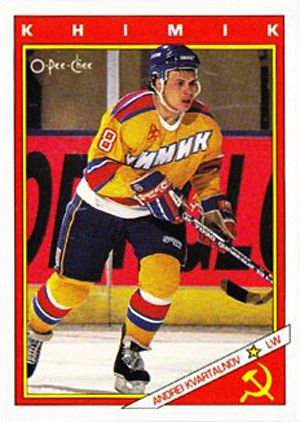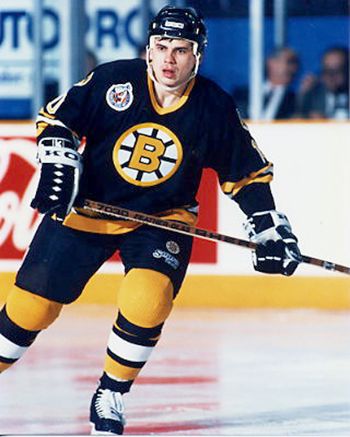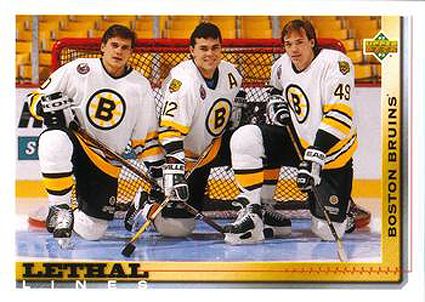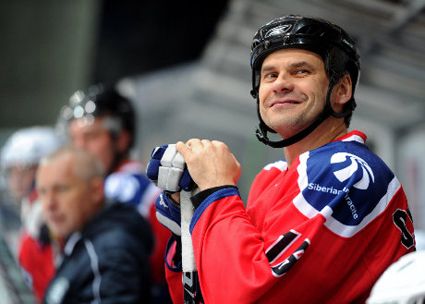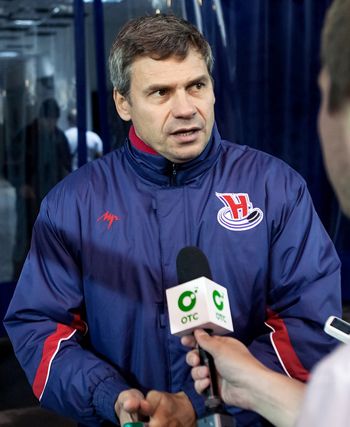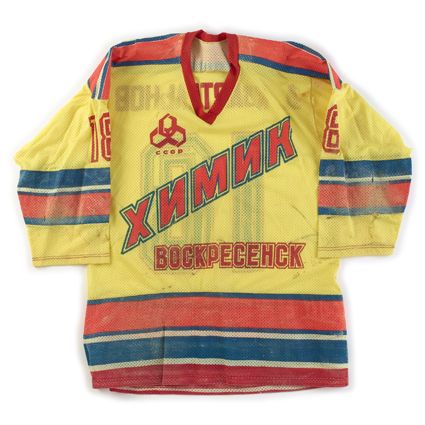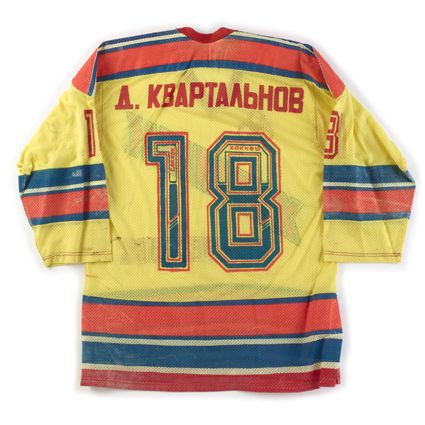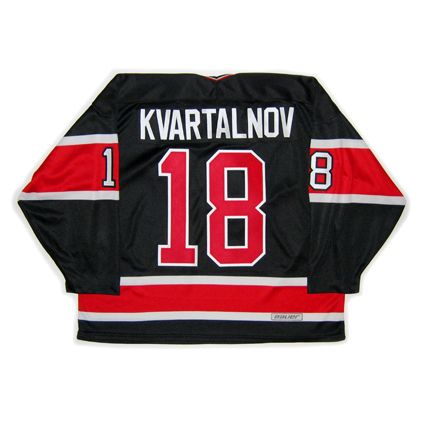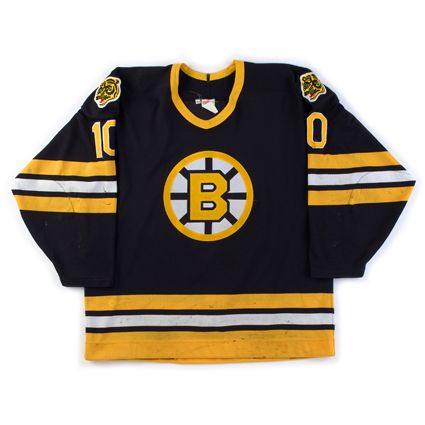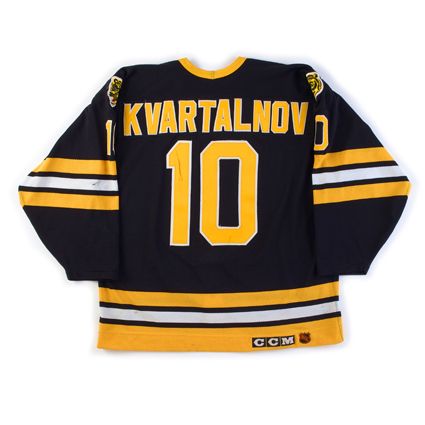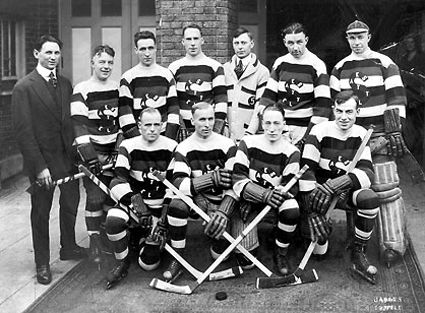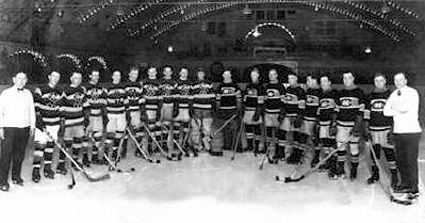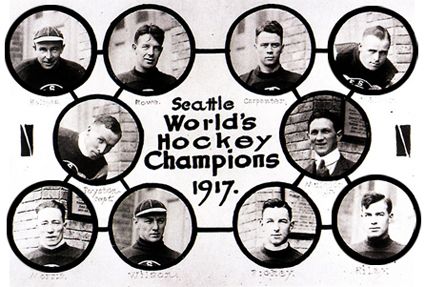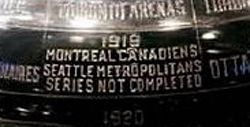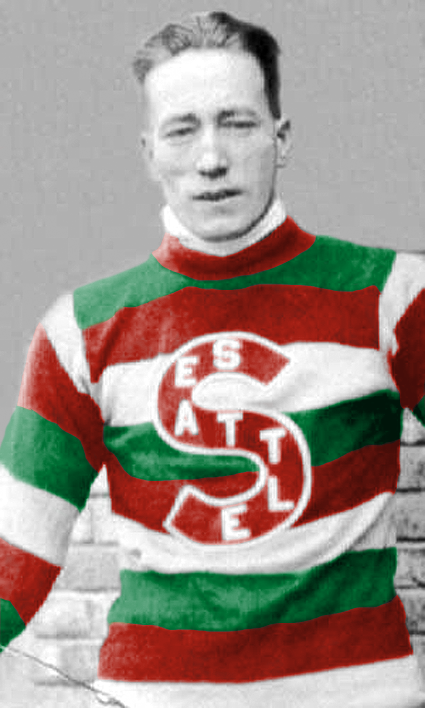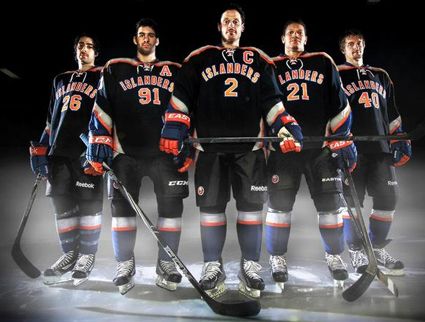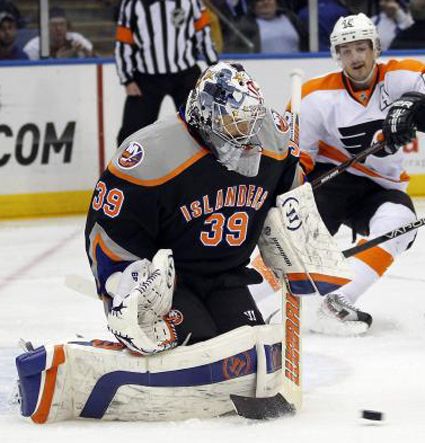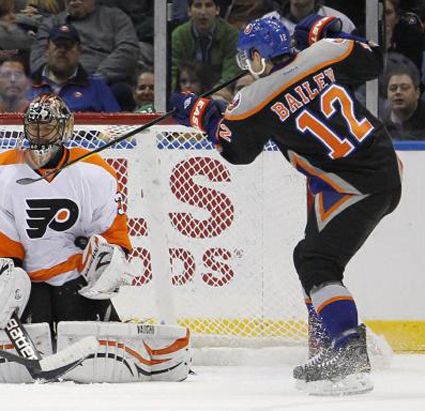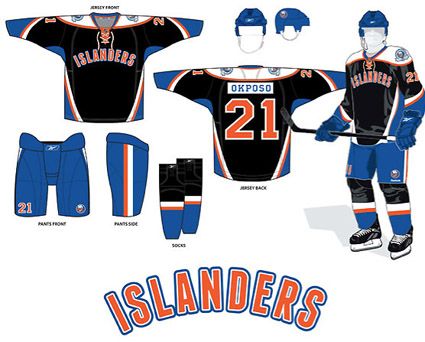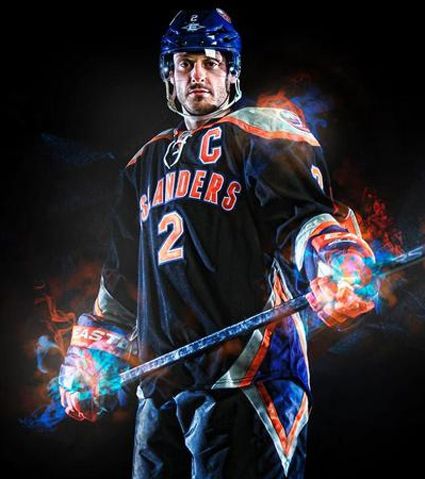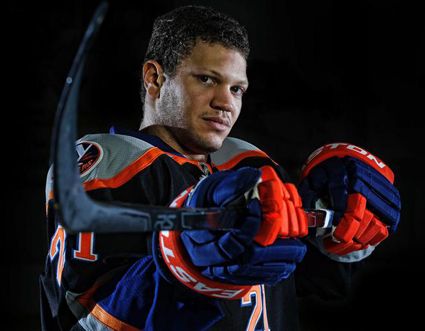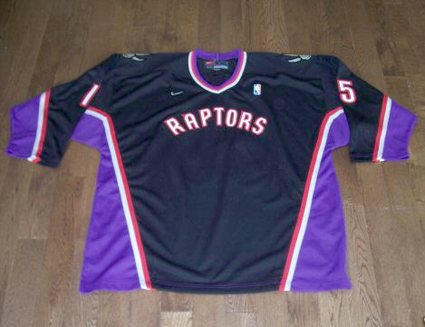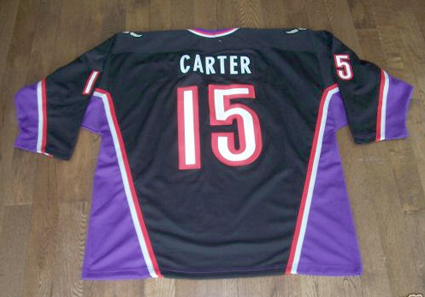Saturday, March 29, 2014
1987-88 Minnesota North Stars Jon Casey Jersey
Born on this date in Grand Rapids, Minnesota in 1962, goaltender Jon Casey played college hockey for the University of North Dakota Fighting Sioux from 1980-81 until 1983-84, which included an appearance at the World Junior Tournament in 1982 for the United States and two NCAA national championships in 1980 and 1982.
Casey, front left, celebrates the 1982 NCAA national championship
Following his college career, the undrafted Casey would sign a free agent contract with the Minnesota North Stars in time for him to see action in two games at the conclusion of the 1983-84 season, which included his first NHL victory.
He spent the following season honing his craft with the Baltimore Skipjacks of the AHL, going 30-11-4 in 46 games. The following season was split between the Springfield Indians (9 games) and North Stars (26 games), with whom he went 11-11-1.
1986-87 saw Casey again spend the entire season in the minors, with both the Indians and the Indianapolis Checkers, where he spent the majority of his time. While he made 14 appearances with Minnesota in 1987-88, most of his action came with the Kalamazoo Wings of the IHL with whom he went 24-13-5.
The departure of Don Beaupre to Washington opened up a roster spot for Casey in Minnesota in 1988-89, who assumed the starting role with 55 games played, a total which increased to 61 the following year during which he set a career high with 31 victories. Following the NHL season, Casey made his only appearance at the World Championships, going 4-2 in six games.
The 1990-91 season saw Casey finish the season with 55 appearances and a 21-20-11 record, but come to life with a 14-7 mark in the playoffs as the North Stars made an improbable run to the Stanley Cup Finals after a posting a losing 27-39-14 record as a team during the regular season.
After two more seasons in Minnesota, making 52 then 60 appearances as well as playing in the 1993 NHL All-Star Game, Casey was traded to the Boston Bruins for the 1993-94 season where he was once more the starting goaltender with 57 appearances.
After his only season with the Bruins, Casey returned to the midwest by signing a free agent deal with the St. Louis Blues for 1994-95 to back up incumbent Curtis Joseph. After appearing in 19 games for St. Louis that season, Casey was limited to just 9 games in 1995-96 as he spent the majority of his time with the Peoria Rivermen of the IHL playing in 43 games.
His final NHL season saw him play 15 games for the Blues as well as 4 with the Worcester IceCats of the AHL. Casey would play one final season of professional hockey with the IHL's Kansas City Blades in 1997-98 prior to retiring in December of 1997 after 24 games with the Blades.
Casey's final NHL totals are 425 games played, 170 wins, 157 losses and 55 ties. He also posted 16 shutouts and a career goals against average of 3.21.
Today's featured jersey is a 1987-88 Minnesota North Stars Jon Casey jersey which features the "JM" patch worn in honor of John Mariucci, "The Godfather of American Hockey". Mariucci played for the University of Minnesota, five seasons for the Chicago Blackhawks, when American players in the NHL was a rarity, and then spent four more seasons playing in the various minor leagues of the day before retiring and entering the world of coaching.
Mariucci coached the University of Minnesota for 12 seasons with another spent as the coach of the US Olympic team, earning a silver medal in 1956. He would also coach Team USA at the 1976 and 1977 World Championships. The home of the Minnesota Golden Gophers, Mariucci Arena, is named for John and he is a member of the United States Hockey Hall of Fame and the Hockey Hall of Fame.
The North Stars adopted this style jersey for the 1978-79 season. This jersey would remain unchanged until 1988-89 with the addition of black to the striping pattern despite the white jerseys having black first added back in 1981, seven years earlier.
Labels:
Casey Jon,
Minnesota North Stars
Friday, March 28, 2014
2014 NCAA Hockey Championship Regionals
The 2014 NCAA Men's Division I Ice Hockey Championships get underway today with the #3 seeded Union Dutchmen of the ECAC, the only team to win both it's regular season and playoff championships, taking on the #13 Vermont Catamounts of Hockey East in the first game of the East Regional in Bridgeport, CT at 2:00 PM eastern time on ESPNU. Vermont was one of five teams from Hockey East to qualify for the NCAA's, the most of any conference.
Play in the Midwest Regional in Cincinnati, OH begins with the WCHA champions the #5 Ferris State Bulldogs up against the #12 Colgate Raiders, runners up in the ECAC at 4:30 online at ESPN3.com.
Goaltender C. J. Motte of Ferris State is among the Hobey Baker
candidates who are still playing for the NCAA championship
One hour later, last year's runner up, the #5 Qunnipiac Bobcats, third in the ECAC and with a nation leading 1.67 goals against average will battle the #11 Providence Friars, another of the qualifiers from Hockey East in the second game of the East Regional, also on ESPNU.
The day wraps up with a primetime matchup when former WCHA rivals, the #4 Wisconsin Badgers of the Big Ten renew old acquaintances with the #14 University of North Dakota of the NCHC, who only got into the field when Wisconsin defeated #19 Ohio State in overtime of the Big Ten conference tournament, as a win by Ohio State would have cost North Dakota it's place in the national championship playoffs. Their game in the Midwest Regional will complete the Friday ESPNU tripleheader.
Saturday sees action in the Northeast Regional in Worcester, MA begin with the #2 Boston College Eagles, champions of Hockey East, battling NCHC tournament champions the #23 Denver Pioneers at 4:00 on ESPNU.
Johnny Gaudreau and Boston College teammate
Kevin Hayes are both finalists for the Hobey Baker
In St. Paul, the West Regional begins with the #1 seed, the Minnesota Golden Gophers, with the nation's leading offense at 3.48 goals per game of offense and champions of the Big Ten hosting the upset minded #44 Robert Morris Colonials, winners of the Atlantic Hockey conference tournament at 5:30 on ESPN2.
The second game of the Northeast Regional gets underway at 7:30 PM when UMass Lowell River Hawks, #7 seed and Hockey East conference tournament champions skate against the #10 Minnesota State Mavericks, WCHA tournament champions online at ESPN3.com.
The first round is completed with the #9 St. Cloud State Huskies of the NCHC against the #8 Notre Dame Fighting Irish, who are competing in their first season in Hockey East, in a West Regional game which will air on ESPNU at 9:00.
Nic Dowd could make it back to back Hobey Baker
winners for St. Cloud State
While the first round games in both the Northeast and West regionals are taking place on Saturday, the winners of the East and Midwest regionals will be deciding who will advance to the Frozen Four in Philadelphia, PA April 10th and 12th. The final of the East Regional will be at 5:00 on ESPNU and the Midwest Regional will be decided at 6:30 on EPSNU.
Saturday's first round winners will advance to play on Sunday, with the Northeast Regional to be decided at 3:00 on ESPN2 and the Midwest Regional will determine the final spot in the Frozen Four at 7:30 on ESPNU.
Today's featured jersey is a 1993-94 Providence Friars Erik Peterson jersey. Providence College was a charter member of Hockey East when it was founded for the 1984-85 season with seven teams, with the Friars making it to the NCAA championship final that season, the third and most recent Frozen Four in school history, with the previous ones coming in 1964 and 1983, but their only appearance in the final.
Providence has won the Hockey East tournament twice, 1985 and 1996, and won the ECAC tournament in both 1964 and 1981 prior to joining Hockey East. 1964 also saw the Friars win the ECAC regular season championship as well.
Hockey East earned it's first national championship in 1993 when the Maine Black Bears took home the crown and in 1995 the conference monopolized the final when Maine lost to Boston University in the championship final, a feat repeated in 1999 when Maine downed the New Hampshire Wildcats for a second All-Hockey East final.
Since then Boston College won the national championship in 2001and again in 2008. Cross-town rivals Boston University rose to the top in 2009 and Boston College completed the Hockey East national title hat trick in 2010. The most recent championship for Hockey East came in 2012 when Boston College won the eighth championship for Hockey East.
With the addition of Notre Dame this season and the Connecticut Huskies for next season, Hockey East will have grown to 12 teams.
Labels:
NCAA,
Providence Friars
Thursday, March 27, 2014
1986-87 University of North Dakota Tony Hrkac Jersey
On this date in 1987, the University of North Dakota Fighting Sioux, led by 1987 Hobey Baker winner and national scoring champion Tony Hrkac and future NHL All-Star Ed Belfour, captured the NCAA championship at the Joe Louis Arena in Detroit, Michigan by defeating the Michigan State Spartans by a score of 5-3.
The NCAA tournament began with eight teams meeting in the quarterfinals, which were still a two-game, total-goals format.
The Minnesota Golden Gophers, second in the WCHA defeated the Boston College Eagles, the champions of Hockey East, 4-1 in the first game. While the Eagles would win the second game 3-2, Minnesota's three goal advantage from Game 1 stood up to take the series 6-4.
The Michigan State Spartans, second in the CCHA regular season and winners of their conference tournament, easily dispatched the Maine Black Bears 11-5 to advance to face Minnesota in the Final Four in Detroit, 90 miles from the Spartans' campus.
In the other half of the bracket, WCHA champions North Dakota took two from the St. Lawrence Saints, third in the ECAC, to win 9-4.
In the final pairing, the Harvard Crimson, champions of the ECAC, destroyed the CCHA champion Bowling Green Falcons in Game 1 by a score of 7-1, taking an insurmountable six goal lead into Game 2, which they easily won 3-0 for a final tally of 10-1.
Michigan State survived their semifinal game in Detroit against Minnesota 5-3, aided in part by a fluke goal when the puck caromed off the seam in the Zamboni doors behind the Minnesota goal, leaving Minnesota goaltender John Blue miles out of his crease waiting for the ring-around while the puck deflected into the slot for an easy shot into the unguarded net for the Spartans.
North Dakota advanced to the final with a stout 5-2 win over Harvard.
In the championship final, North Dakota prevailed by a score of 5-3 over the partisan Michigan State crowd which numbered an NCAA record 17,644 fans in attendance. Ian Kidd opened the scoring for North Dakota in the first period with a backhander before defenseman Murray Baron added another 1:37 later to make it 2-0 for the Fighting Sioux. Just 18 seconds later Bob Joyce scored from Hrkac and Kidd, North Dakota's third goal in the span of just 1:55.
Michigan State got a goal back in the second period, which North Dakota soon countered to restore the three goal cushion before future NHLer Kevin Miller scored for the Spartans to make it 4-2 after two periods.
Each team would add a goal in the third for the final score of 5-3 as the Gino Gasparini coached team earned their fifth national championship and set a record with their 40th win of the season to finish the season at 40-8.
Each team would add a goal in the third for the final score of 5-3 as the Gino Gasparini coached team earned their fifth national championship and set a record with their 40th win of the season to finish the season at 40-8.
Hrkac led the tournament in scoring with 3 goals and a record 9 assists for 12 points and was named to the All-Tourament team along with teammates Belfour, defnseman Kidd and linemate Joyce.
Hrkac also led the nation in scoring that season with 116 points in 48 games, far outdistancing his nearest competitor by 24 points to set an NCAA record, while Joyce and Hrkac finished 1-2 in goals with 52 and 46. Hrkac's outstanding season was recognized with the Hobey Baker Award, given annually to the top player in American college hockey also on this date in 1987.
Tony Hrkac posing with the Hobey Baker Award
After playing two seasons at North Dakota, Hrkac would immediately enter the NHL with the St. Louis Blues. In addition to the Blues, he would also play with the Quebec Nordiques, San Jose Sharks, Chicago Blackhawks, Dallas Stars, which included winning a Stanley Cup in 1999, a brief stint with the New York Islanders, the Mighty Ducks of Anaheim and the Atlanta Thrashers. Periodically, Hrkac would spend time in both the AHL and the IHL, including a standout season in 1992-93 with the Indianapolis Ice, where he would win the league scoring title with 132 points and be named the league MVP. In 2004, he would help the Milwaukee Admirals capture the Calder Cup in the AHL playoffs.
Joyce saw action in the NHL with the Boston Bruins, Washington Capitals and Winnipeg Jets as well as several years in the IHL before finishing his career with three seasons in Germany.
Freshman defenseman Baron would have the most successful NHL career among the skaters, playing 988 games with the Philadelphia Flyers, St. Louis Blues, Montreal Canadiens, Phoenix Coyotes and Vancouver Canucks, but easily the most recognizable name off the 1986-87 Fighting Sioux roster would be goaltender Belfour.
After playing a single season with North Dakota, Belfour would break into the NHL in a big way in 1990-91, winning the Calder Trophy, the Jennings Trophy and the Vezina Trophy with the Chicago Blackhawks while posting a record of 43-19-7. The next season he would lead the Blackhawks to the Stanley Cup Finals for the first time in 19 years. He would also repeat capturing both the Jennings and Vezina trophies in 1992-93. During his nine seasons in Chicago, Belfour would establish himself as one of the elite goalies in the NHL.
After a brief stay in San Jose, Belfour would join the Dallas Stars, backstopping the team to the Stanley Cup in 1999, while winning another Jennings Trophy, and a return to the finals in 2000. He would close out his 19 year NHL career with three seasons in Toronto with the Maple Leafs and a season with the Florida Panthers.
Today's featured jerseys is a 1986-87 University of North Dakota Fighting Sioux Tony Hrkac jersey. This classic Fighting Sioux jersey is clearly derived from the traditional Chicago Blackhawks jersey, only with the Blackhawks red replaced by the green of the Fighting Sioux and with the "C" in the crossed tomahawks secondary logo replaced by an "S".
A much beloved style among Fighting Sioux fans, this style was first used in 1978 and lasted through 1993 when political correctness resulted in a "North Dakota word mark" style for a couple of seasons until stylized "geometric" Indian head was employed. While today's featured style came into being in 1984, the use of the "Blackhawks" crest dates back to 1971.
For the most complete history of North Dakota jerseys online, we highly recommend Sioux-Jersey.com.
Bonus jersey: Today's bonus jersey is a 1986-87 University of North Dakota Fighting Sioux Ed Belfour jersey as worn by Belfour in his NCAA national championship season. No names were used on the back of the North Dakota road jerseys at that time and Belfour wore #29 in college rather than the more familiar #30 he would later wear in the NHL.
For more on the issue surrounding the discontinuation of the "Fighting Sioux" name, please read our post here.
A much beloved style among Fighting Sioux fans, this style was first used in 1978 and lasted through 1993 when political correctness resulted in a "North Dakota word mark" style for a couple of seasons until stylized "geometric" Indian head was employed. While today's featured style came into being in 1984, the use of the "Blackhawks" crest dates back to 1971.
For the most complete history of North Dakota jerseys online, we highly recommend Sioux-Jersey.com.
Bonus jersey: Today's bonus jersey is a 1986-87 University of North Dakota Fighting Sioux Ed Belfour jersey as worn by Belfour in his NCAA national championship season. No names were used on the back of the North Dakota road jerseys at that time and Belfour wore #29 in college rather than the more familiar #30 he would later wear in the NHL.
For more on the issue surrounding the discontinuation of the "Fighting Sioux" name, please read our post here.
Here is a great find, highlights of both the semi-final game against Harvard followed by the title winning game against Michigan State.
Here is a music video tribute to the 1987 North Dakota Fighting Sioux, featuring perhaps the worst performance of the most annoying song ever written, but the rare footage of the team in action is worth the audio punishment. No points will be deducted for watching with the sound off.
Finally, a look back at the career of Hrkac on the occasion of his induction into the Northwestern Ontario Sports Hall of Fame.
Labels:
Belfour Ed,
Hrkac Tony,
NCAA,
University of North Dakota,
WCHA
Wednesday, March 26, 2014
1968-69 St. Louis Blues Barclay Plager Jersey
One of the most popular players in St. Louis Blues history, Barclay Plager was born on this date in 1941. Barclay was the oldest of the three Plager brother to play in the NHL, followed by Bill and Bob.
Barclay began his road to the NHL playing for the Peterborough Petes on the Ontario Hockey Association in 1957-58. During his four seasons playing for the Petes, Barclay established a himself as a rugged, tough defenseman, a reputation only enhanced by a fight he had with his brother Bob, who was playing for the Guelph Royals.
Barclay, accidentally he claimed, jammed his stick in Bob's mouth and Bob responded with his fists. "We went at it pretty good on the ice," Bob remembers, "but they broke it up. As we went into the penalty box he gave me a shove and we started fighting again. Then, after we were thrown out of the game, we continued to battle in the runway leading to the dressing rooms. But I got the best of him for the first time. Afterwards I met him in a restaurant across the street from the rink. I was sitting there eating when he walked in. We looked at each other and I didn't know what was going to happen. The whole Guelph team rushed into the place to see. Everyone figured we'd go at it again, but Barclay just looked me in the eye and said, 'Can you lend me five dollars?'"
Like many players of his era, Plager found himself mired in the minor leagues, unable to crack the exclusive ranks of the NHL, which was then only six member clubs which afforded approximately 30 jobs to defensemen league wide.
Plager began his travels through the minor leagues with a stop in Hull in 1961-62, Edmonton and Pittsburgh in 1962-63, Omaha in 1963-64, where he had an outstanding season with 75 points where he led the league in both assists and penalty minutes by wide margins as Omaha captured the CPHL's inaugural Adams Cup, and Springfield in 1964-65 and 1965-66 before splitting time between Springfield and Omaha in 1966-67.
Just when it looked as if Plager would toil in the minors for the remainder of his playing days, the NHL expansion of 1967-68 doubled the size of the league overnight, creating twice as many job opportunities than previously available.
With his rights acquired by the St. Louis Blues from the New York Rangers, Plager embarked on a new phase of his career in the NHL. While the Blues finished third in the "Western" division, comprised of the six new expansion clubs, they outlasted both the Philadelphia Flyers and Minnesota North Stars to qualify for the Stanley Cup Finals in only their first season in the NHL. Although Plager only played in 49 of the Blues games due to spending 20 games with the Buffalo Bisons of the AHL, Plager's no nonsense approach to his game led to a league leading 153 penalty minutes. Barclay was also joined on the Blues blueline by his brother Bob who arrived via a trade with the Rangers.
In 1968-69, backed by veteran goaltenders Glenn Hall and Jacques Plante, Plager and the Blues defensive corps of Al Arbour, Jean-Guy Talbot, veteran Doug Harvey, Noel Picard, Jim Roberts, Bob Plager, Terry Crisp and Ron Schock shockingly allowed the least goals against by a country mile, 39 less than the New York Rangers and 68 less an any of their expansion cousins to win the Vezina Trophy for Hall and Plante.
"We did anything to protect the goaltender," recalled Bob Plager. "The greatest time for us was the year we won the Vezina Trophy. Glenn Hall and Jacques Plante were in goal and we only allowed 157 goals. That record will probably never be broken. Winning the Vezina was the finest reward anyone could get."
Of note, Bill Plager arrived in St. Louis for a pair of games, giving St. Louis all three brothers at the same time.
Barclay, Bill and Bob Plager lacing up their skates for the Blues
The Blues again returned to the Stanley Cup Finals after eliminating the Flyers and Los Angeles Kings.
The Blues were again stingy on defense, coming in second to Boston but 46 goals better than any other "Second 6" franchise and again made their annual trip to the finals, but once again they were swept by an Original 6 franchise. Barclay led the Blues in trips to the penalty box that season, besting his brother Bob 128 penalty minutes to 113.
Barclay, Bob and Bill would play for the Blues during parts of three seasons, with the limiting factor being mainly Bill's number of games played, as he had 2 in 1968-69, 24 in 1969-70 and 36 during his final season with the Blues in 1970-71 before moving on to the Atlanta Flames and considerably more playing time.
For the next six seasons, Barclay would continue to provide his rock-steady defensive play and offensive output, as he would play no less than 54 games while scoring between 26 and 33 points, which was Plager's NHL career high. Additionally, he was named team captain in 1972, a position he would hold until 1976.
After one more season in St. Louis, Barclay would play just two final games for the Blues before being named as a player/coach for the Kansas City Blues in 19767-77. He remained an effective player and as well as a team leader, as coach Plager guided his team to the CHL finals, while Plager the player was named as the league's MVP.
He served the same dual roles in 1977-78 with the Salt Lake Golden Eagles, which would prove to be his final season as an active player.
He remained with the Blues organization as a scout and an assistant coach before being named the club's head coach for the 1978-79 season.
His number 8 was retired by the Blues on March 24, 1981.
Plager's final NHL stats were 44 goals and 187 assists for 231 points along with 1,115 penalty minutes, which included leading the team on four separate occasions, and 15 broken noses, a testament to his bruising, shot blocking ways which earned him the hearts of the fans.
Today's featured jersey is a 1968-69 St. Louis Blues Barclay Plager jersey as worn by the Blues during their second ever season, one in which they would make it all the way to the Stanley Cup Finals.
This jersey style, introduced during the Blues first season of 1967-68, would remain in use through 1972-73 when the colors of the striping were reversed, with names arriving on the back in 1977-78. That similar style would survive through the 1978-79 season when additional trim was added to the shoulder yoke, keeping it in line with the striping on the shoulders of the white jerseys.
Bonus Jersey: Today's bonus jersey is a 1973 NHL All-Star Game Barclay Plager jersey. Plager played in the NHL All-Star Game on four occasions, 1970, 1971, 1973 and 1974. This particular jersey was worn by Barclay Plager during the 1973 edition held in New York's Madison Square Garden.
This was the first year for this brand new style of All-Star jersey and it would be worn for eight All-Star Games through 1981, skipping 1979 when a slightly different jersey was worn for the Challenge Cup against the Soviet Union instead of the normal all-star game format.
Today's video selection features the Plager brothers, Barclay, Bob and Bill.
Labels:
Plager Barclay,
St. Louis Blues
Tuesday, March 25, 2014
1989-90 Khimik Voskresenek Dimitri Kvartalnov Jersey
Born on this date in 1966, Dimitri Kvartalnov looked for all the world to be on his way to NHL stardom.
Kvartalnov then moved to North America and joined the San Diego Gulls of the International Hockey League, where he destroyed the league, scoring 60 goals and 58 assists for 118 points in 77 games. Kvartalnov picked up a trio of awards that season as the Rookie of the Year, Scoring Champion and Most Valuable Player.
Kvartalnov began his career with five full seasons with Khimik Voskresenek of the Soviet League, which included leading the league in scoring in 1989-90 and playing for the Soviet Union in the World Championships twice, winning gold in 1989 and bronze in 1991.
Dimitri, incorrectly identified as his brother Andrei
Kvartalnov then moved to North America and joined the San Diego Gulls of the International Hockey League, where he destroyed the league, scoring 60 goals and 58 assists for 118 points in 77 games. Kvartalnov picked up a trio of awards that season as the Rookie of the Year, Scoring Champion and Most Valuable Player.
IHL scoring champion Kvartalnov
Following his stellar IHL season, the Boston Bruins selected Kvartalnov with the 16th pick in the 1992 NHL Entry Draft.
Already with ten years of pro experience and entering the prime of his career at age 26, his NHL career got off to a record start in 1992 with 12 goals and ten assists to give him points in his first 14 games, a mark that would stand for fifteen years until surpassed by Evgeni Malkin in 2007.
Playing on "The Bonanza Line" of Adam Oates (Adam) and fellow NHL rookie Joe Juneau (Little Joe) and Kvartalnov (Hoss), the line would score nearly a third of the Bruins goals that season, with 107 of the club's 332 for the year. Oates would finish third in league scoring with 142 points and Juneau topped 100 with 102 while setting a record for left wingers with 70. Kvartalnov would amass 30 goals and 42 assists for 72 points in 73 games in his first season and had the look of a future NHL star - at least on the outside.
The first sign of trouble was when the Bruins left him unprotected in the expansion draft, and despite his 30 goal season seemingly indicating enormous potential, he went unclaimed.
Once the season began, Kvartalnov found himself in coach Brian Sutter's doghouse. Sutter, who had little use for Kvartalnov's apparent one dimensional style of play, left him out of the lineup on many occasions during his second season. After 39 games, in which he scored just 19 points, half the pace of a year before, and with a -9 rating, Kvartalnov was placed on waivers and eventually demoted to Providence of the AHL. There he was back to a point a game, but his time with the Bruins and North America was over at the conclusion of the season.
Once the season began, Kvartalnov found himself in coach Brian Sutter's doghouse. Sutter, who had little use for Kvartalnov's apparent one dimensional style of play, left him out of the lineup on many occasions during his second season. After 39 games, in which he scored just 19 points, half the pace of a year before, and with a -9 rating, Kvartalnov was placed on waivers and eventually demoted to Providence of the AHL. There he was back to a point a game, but his time with the Bruins and North America was over at the conclusion of the season.
His career was far from over however.
Kvartalnov would move to Switzerland and play three seasons with HC Ambri-Piotta, finishing third in league scoring in 1995-96 and leading the team in scoring in 1996-97.
Klagenfurt AC in Austria was his next stop, where he would play for three seasons which included leading the team in scoring with 72 points in 45 games in 1997-98.
He would split the 1999-00 season between the Manheim Eagles in Germany and Jokerit Helsinki in Finland.
The following season he would return to Russia, joining Ak Bars Kazan where he would play for four seasons and lead them in scoring twice. 2004-05 saw a move to Cherepovets Severstal and then a return to Khimik for six games. He would play the 2005-06 season with Krylja Sovetov (Soviet Wings) in the lower division, helping them regain a place in the top league for 2006-07. Half way through the season Kryla would deal Kvartalnov back to Cherepovets, and he would retire at the conclusion of the season after a 24 year professional career in which he would score a total of 509 goals and 474 assists for 983 points.
Kvartalnov has subsequently gone into coaching and has led Severstal Cherepovets for three seasons before joining Sibir Novosibirsk.
Kvartalnov has subsequently gone into coaching and has led Severstal Cherepovets for three seasons before joining Sibir Novosibirsk.
Today's featured jersey is a 1989-90 Khimik Voskresenek Dimitri Kvartalnov jersey as worn by Kvartalnov when he was the leading scorer in the Soviet League. It's typical of the Soviet jerseys of the era in that it is a relatively lightweight mesh and all the elements are either dye sublimated or screened on. Of note are the wild numbers on the back, reminding us of the 1982 movie "TRON". This jersey also has Dimitri's first initial "D" on the back in Cyrillic, as his brother Andrei was also a member of the team. The shape of the Cyrillic "D" likely led to the confusion and his being identified on his O-Pee-Chee hockey card as Andrei.
We obtained this jersey from a member of the Khimik traveling party during a game at Met Center in Bloomington, Minnesota when Khimik was playing a game in the Super Series against the Minnesota North Stars. Having no real idea who the players on the club were at the time, and being given our choice of a few different jerseys, we opted for the one with the longest name simply because it looked the most "Soviet". Only later when we decoded the Cyrillic lettering did we realize we had unknowingly obtained the jersey from the Soviet League's leading scorer from the prior season!
Bonus jersey: Today's bonus jersey is a 1991-92 San Diego Gulls Dimitri Kvartalnov jersey. version of the Gulls played in the IHL from 1990-91 to 1994-95 before moving north to become the Los Angeles Ice Dogs for one season prior to becoming the Long Beach Ice Dogs.
The Gulls wore the same striking black and red jerseys for their entire run in San Diego and are easily our favorites of any of the four teams to have used the San Diego Gulls name.
Extra bonus jersey: Today's extra bonus jersey is a 1993-94 Boston Bruins Dimitri Kvartalnov jersey. As well as obtaining Kvartalnov's game worn Khimik jersey, we later acquired his Bruins road jersey from his second season in the NHL. When paired with our Khimik jersey from the Soviet League, we like to call it our "Ultimate Home and Away Jerseys".
The Gulls wore the same striking black and red jerseys for their entire run in San Diego and are easily our favorites of any of the four teams to have used the San Diego Gulls name.
Extra bonus jersey: Today's extra bonus jersey is a 1993-94 Boston Bruins Dimitri Kvartalnov jersey. As well as obtaining Kvartalnov's game worn Khimik jersey, we later acquired his Bruins road jersey from his second season in the NHL. When paired with our Khimik jersey from the Soviet League, we like to call it our "Ultimate Home and Away Jerseys".
In today's video section, you cannot defend passing this good. You just can't.
Next, Kvartalnov picks up a rolling puck and shows his soft hands as he stickhandles his way to a nifty goal against the Hartford Whalers.
Next, Kvartalnov receives a laser pass from the playmaker Oates and, showing the good skills with his skates many European hockey players have from growing up playing soccer, gets the puck up to his stick and scores against the Washington Capitals Olaf Kolzig.
Finally, we present you with the theme song to the TV series Bonanza, from where the Bruins Bonanza Line of Oates, Juneau and Kvartalnov got their name.
Monday, March 24, 2014
1916-17 Seattle Metropolitans Bernie Morris Jersey
The Pacific Coast Hockey League was founded in 1911 by Frank and Lester Patrick. After three seasons the league expanded into the United States for the first time with the addition of the Portland Rosebuds, who were joined the following season by the Seattle Metropolitans.
The Metropolitans finished third in the four team league with a 9-9 record. They were led in scoring by Bernie Morris, who scored 23 goals and 9 assists in the 18 game schedule while Harry "Hap" Holmes held down the goaltending duties.
During the Metropolitans second season, Morris again led the club in scoring with a stellar 37 goals and 17 assists for 54 points in 24 games to lead the league in scoring as Seattle edged the Vancouver Millionaires to the regular season title with a 16-8 record. Additionally, Holmes led all goalkeepers that season with a 3.3o goals against average, well over a goal better than his next closest competition.
Unlike the Eastern National Hockey Association, which held a post season playoff to determine the league champion, Seattle advanced to the Stanley Cup Final simply by virtue of finishing first.
The 1917 Stanley Cup finalists, the Seattle Metropolitans and the Montreal Canadiens
The Metropolitans hosted the defending cup holders, the Montreal Canadiens, in a best of five series at the Seattle Ice Arena. The Canadiens defeated Seattle 8-4 in Game 1 held under PCHA rules as Didier Pitre scored four times for Montreal.
Game 2, held under NHA rules, saw the Metropolitans even the series with a dominant 6-1 win. Alternating back to PCHA rules, Seattle and Holmes again held Montreal to a single goal while Seattle scored 4 to take a 2-1 series lead.
Held on this date in 1917, Game 3 was all Seattle. Morris alone outscored Montreal, and by a wide margin, as he scored 6 of the Metropolitans goals as they won going away by a score of 9-1 to become the first team based in the United States to win the Stanley Cup in it's 24 year history. During the series Morris would account for 14 of Seattle's 23 goals.
The following season the Metropolitans would finish first overall during the regular season with an 11-7 record, but would lose their hold on the Stanley Cup when they were defeated in the newly instituted PCHA playoffs.
They turned the tables in 1918-19 by defeating the Millionaires to advance to the 1919 finals. Tragically, after the series with the Canadiens was tied at 2-2-1, several of the players from Montreal fell ill with the Spanish Influenza, which caused the cancellation of the remainder of the series and would claim the life of Montreal's Joe Hall.
The 1919 Stanley Cup engraving
The 1919-20 PCHA season was extraordinarily tight, with the Metropolitans finishing first with a 12-10 record to the Millionaires 11-11 and the Victoria Aristocrats 10-12. Seattle again won the PCHA playoff and qualified for the Stanley Cup Finals for the third time in four years, but came up short in five games against the Ottawa Senators.
Seattle finished with a 12-11-1 record in 1920-21 and missed out on a chance to return to the Stanley Cup Finals with a loss in the PCHA playoff. Parity again reigned in 1921-22 as Seattle finished first at 12-11-1 over the Millionaires at 12-12 and Victoria just behind at 11-12-1.
With games against teams from the Western Canada Hockey League counting in the PCHA standings, the Metropolitans finished last in the league despite a .500 record of 15-15.
The same system was in place for the 1923-24 season, and with the WCHL teams having improved since the previous season, Seattle oddly finished with the first losing record in franchise history at 14-16, yet finished first overall in the PCHA, ahead of Vancouver's 13-16-1 mark.
Seattle lost the two-game, total-goals playoff with Vancouver 4-3, which would turn out to be the final game for the Metropolitans, as the Seattle Ice Arena owners did not renew the team's lease, which led to the club ceasing operations, which in turn brought a close to the PCHA.
During their nine year run, Frank Foyston would lead the club in scoring with 139 goals and 163 points, followed by Morris with 139 points. Holmes would lead the PCHA in goaltending five times in the six years he was a member of the Metropolitans, including four in a row from 1918-19 to 1921-22.
Today's featured jersey is a 1916-17 Seattle Metropolitans Bernie Morris jersey as worn when he scored six goals in the Metropolitans Stanley Cup clinching goal on this date in 1917.
The Metropolitans would wear a barberpole style jersey throughout their history with minor variations to their "S" crest until 1921, when the word "Seattle" diagonally across the chest.
Morris first played for a number of senior level teams prior to joining the Victoria Aristocrats of the PCHA in 1914-15. He then joined Seattle for eight years. In 1923-24 he was traded to the Calgary Tigers of the WCHL and played there for a season and a half before moving east to become a member of the brand new Boston Bruins of the NHL for six games. After being released by the Bruins, Morris returned to the WCHL and became a member of the Regina Capitals. He played the final five seasons of his hockey career with a variety of teams in a series of minor leagues.
Labels:
Morris Bernie,
Seattle Metropolitans
Sunday, March 23, 2014
The New York Islanders Black Alternate Jersey
With the news that the New York Islanders will be wearing their black alternate jerseys for the final time today, we thought it was appropriate to revisit our post which originally ran the day after their debut on November 23, 2011.
With today being Thanksgiving Day in the United States, we felt it was appropriate to name our Turkey of the Year, which made it's on ice debut just last night.
One additional video, this being the Islanders broadcast crew verbally shredding the black alternates earlier this season as they hope they have seen them for the last time. Classic stuff.
A Turkey of a Jersey
For anyone following the NHL, and specifically the news concerning the releases of the new jersey styles, this award should come as no surprise, as the 2011-12 New York Islanders Alternate Jersey is the Third String Goalie Turkey of the Year.
There is so much wrong with this jersey it's not even funny. The main issue being that the jersey is black - which is not one of the Islanders colors. Yes, just as the orange and blue clad New York Mets finally eliminate the extraneous black from their jerseys, it makes the 20 mile drive to the Nassau County Coliseum to invade the Islanders color palette. Not once in the 40 year history of the Islanders has black ever appeared on one of their jerseys. Not during their formative years or subsequent Stanley Cup Dynasty, not during the unfortunate fisherman era, the construction worker vest period. Never, every in any way until it now takes over an entire jersey.
The main cresting of the jersey is also an unexplainable choice of the name "Islanders" in an incredibly generic font, arched over the player number despite the continued criticism the Dallas Stars jerseys have received for the same look for the last four seasons.
There's just nothing about it that generates any excitement or connection to the franchise. It's as generic a treatment as any jersey in NHL history and looks as if it were designed by someone without a license to use copyrighted NHL team logos! We've see so many creative and great looking concept jerseys and logos designed by fans which used a lighthouse logo for the main crest or an updated version of the "NY" incorporating a stick that to just slap the team name on the front without even using something that ties in with the club's identity package seems inexcusable.
Speaking of the club's identity package, the team also chose to employ a different font for both the name on the back as well as the number, bypassing the chance to maintain any continuity across the full set of home, road and alt jerseys.
Additionally, the choice of three colors for the names does not help their legibility. Very few teams use three color names, and a few who did have chosen to simplify them to two color names for increased legibility. About the only saving grace is that the royal blue is the outer color, and when placed on the black it's indiscernible from any distance, essentially reducing the names to two colors anyway.
Speaking of continuity, where's the 40th Anniversary patch worn on the home and road jerseys? Details, people, details!
In addition to our complaint about the fact the jersey is black, we also have an issue with the grey shoulders and striping, another color not used on the Islanders home and road jerseys. using white instead would have at least fit in with the three colors of the home and road jerseys. As it is, the black and grey just create a seriously depressing overall feel when paired with the mid-toned shade of royal blue.
An early leak of one of the other nine proposed designs had white substituted for the grey and it's quite a bit less depressing in feeling, especially when combined with the blue pants with the vertical striping, rather than the awful "hip diamond" mess they went with.
With the Islanders having chosen to produce a black jersey with grey shoulders and zoomy striping that comes to a point on both the sides and arms of the jersey, creating a futuristic "Star Trek" look, what do they choose to do next? A vintage, old-school lace up collar! This was a terrible, terrible choice, as it does not fit with any aspect of the jersey in any way and adds nothing to the look. The jersey would look so much cleaner without it, and it has no business being on a jersey that looks like a "turn ahead the clock" jersey. Just awful.
Terry Goldstein, the Islanders Director of Retail Operations, said "We view this as just a fun, alternative jersey. With our white and our blue jerseys we look back at our history, and with the black jerseys, we're looking forward."
So why does it have an old-fashioned lace up collar?!
Beyond the jersey, the pants they designed to pair with the jersey have an inverted triangle shape, which creates a asymmetrical diamond shape with the corresponding, longer triangle that runs up the sides of the jerseys, another jarringly bad decision, especially in light of the fact the two triangles are not the same width were they meet.
Notice the vapors coming off the player in this photo which we have identified as the smell coming from this absolute stinker of a jersey.
"The jersey has to fit the personality of the team," Goldstein continued. "Currently, the personality of our team and our fans is that they love the traditional royal and white and we're not changing that for a long time, but on a couple of games we wanted to have some fun with something different."
It's too bad they created a depressing jersey instead of a fun one. They did, however, create a jersey which fits the personality of the team - poorly thought out, disorganized and a real mood killer, flat out the worst one we've seen since the 1996 arrival of the Mighty Ducks Wild Wing jersey 16 years ago.
This jersey is so awful, the players appear to be trying to cover up as much of the jersey as possible in the photos of it's release! We've never seen anything quite like it before.
Wait a minute... we have seen it before! This is a "hockey jersey" from the NBA's Toronto Raptors, which can be found on ebay, and appears to be the inspiration for the Islanders new jersey.
Today's videos begin with the public debut of the jerseys, as modeled by the Islanders players, who toe the company line with their praise of the new alternates.
Here is footage from the jerseys in action, where the "diamond" shape made up of the triangle shapes on the jerseys and pants looks truly awful when on the ice.
No doubt we've made our opinion on the Islanders new jersey quite clear, but we'll let the ultimate authority have the final word today.
**********
Labels:
Curious Weird and Ugly,
New York Islanders
Subscribe to:
Comments (Atom)

